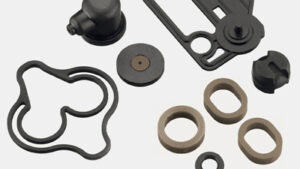Achieving savings in the post-curing process of fluoroelastomer compounds prepared by injection molding
Mattia Ramini, Gian Tommaso Viola, Luisa Paganin, Dott. Viola, Monica Battisti –
Commonly, rubber compounds based on FKM elastomers are subjected to two stages of cure in order to optimize physical and mechanical properties. Compression set and tensile strength are the main properties usually improved by the post-cure stage. The initial stage is called curing, and is performed under pressure in a mold during the injection molding process. A secondary stage called post-cure is performed in an oven under air or nitrogen atmosphere in order to complete crosslinking reactions. This removes volatile by-products and additives to obtain enhanced, stable physical and mechanical properties.
Process aids such as carnauba wax can be volatilized out from FKM compounds during an oven post-cure cycle. Furthermore, FKM parts should not be placed in a post-cure oven with other parts made from different elastomers, especially parts based on silicone rubber, as chemical interactions between silicone rubber and small amounts of hydrogen fluoride generated during the post-cure of the ionic curable FKM compound can damage or destroy parts. Typically, the post-cure stage may be either as short as 2 hours, or as long as 24 hours. Post-cure oven temperatures typically range from 150°C up to 250°C, although temperatures between 200-232°C are most common.
Optimal post-cure operating conditions, mainly time and temperature, depend on specific FKM compound formulation, cure system type (bisphenol or peroxide), and on the required specification.

